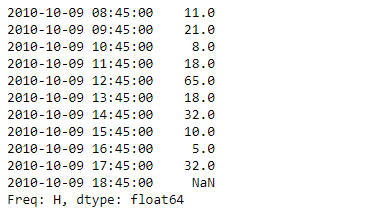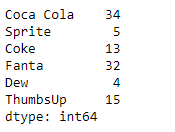Python Pandas Series.autocorr()
Pandas系列是一个带有轴标签的一维ndarray。标签不需要是唯一的,但必须是一个可散列的类型。该对象支持基于整数和标签的索引,并提供了大量的方法来执行涉及索引的操作。
Pandas Series.autocorr()函数计算滞后N自相关。该方法计算系列与其移位后的自身之间的皮尔逊相关性。
语法: Series.autocorr(lag=1)
参数:
lag :在执行自相关之前应用的滞后期数量。
返回 : 浮点数
例子#1:使用Series.autocorr()函数来计算给定系列对象的基础数据的滞后N自相关。
# importing pandas as pd
import pandas as pd
# Creating the Series
sr = pd.Series([11, 21, 8, 18, 65, 18, 32, 10, 5, 32, None])
# Create the Index
index_ = pd.date_range('2010-10-09 08:45', periods = 11, freq ='H')
# set the index
sr.index = index_
# Print the series
print(sr)
输出 :

现在我们将使用Series.autocorr()函数来计算给定系列对象的基础数据的滞后自相关。
# return the auto correlation
result = sr.autocorr()
# Print the result
print(result)
输出 :

正如我们在输出中看到的,Series.autocorr()函数已经成功地返回了给定系列对象的基础数据的滞后1的自动相关。
实例#2 :使用Series.autocorr()函数计算给定系列对象的基础数据的滞后-N自动相关。取滞后值等于3。
# importing pandas as pd
import pandas as pd
# Creating the Series
sr = pd.Series([34, 5, 13, 32, 4, 15])
# Create the Index
index_ = ['Coca Cola', 'Sprite', 'Coke', 'Fanta', 'Dew', 'ThumbsUp']
# set the index
sr.index = index_
# Print the series
print(sr)
输出 :

现在我们将使用Series.autocorr()函数来计算给定系列对象的基础数据的滞后自相关。
# return the auto correlation
# by lag-3
result = sr.autocorr(lag = 3)
# Print the result
print(result)
输出 :

正如我们在输出中看到的,Series.autocorr()函数已经成功地返回了给定系列对象的基础数据的滞后1的自动相关。
 极客教程
极客教程